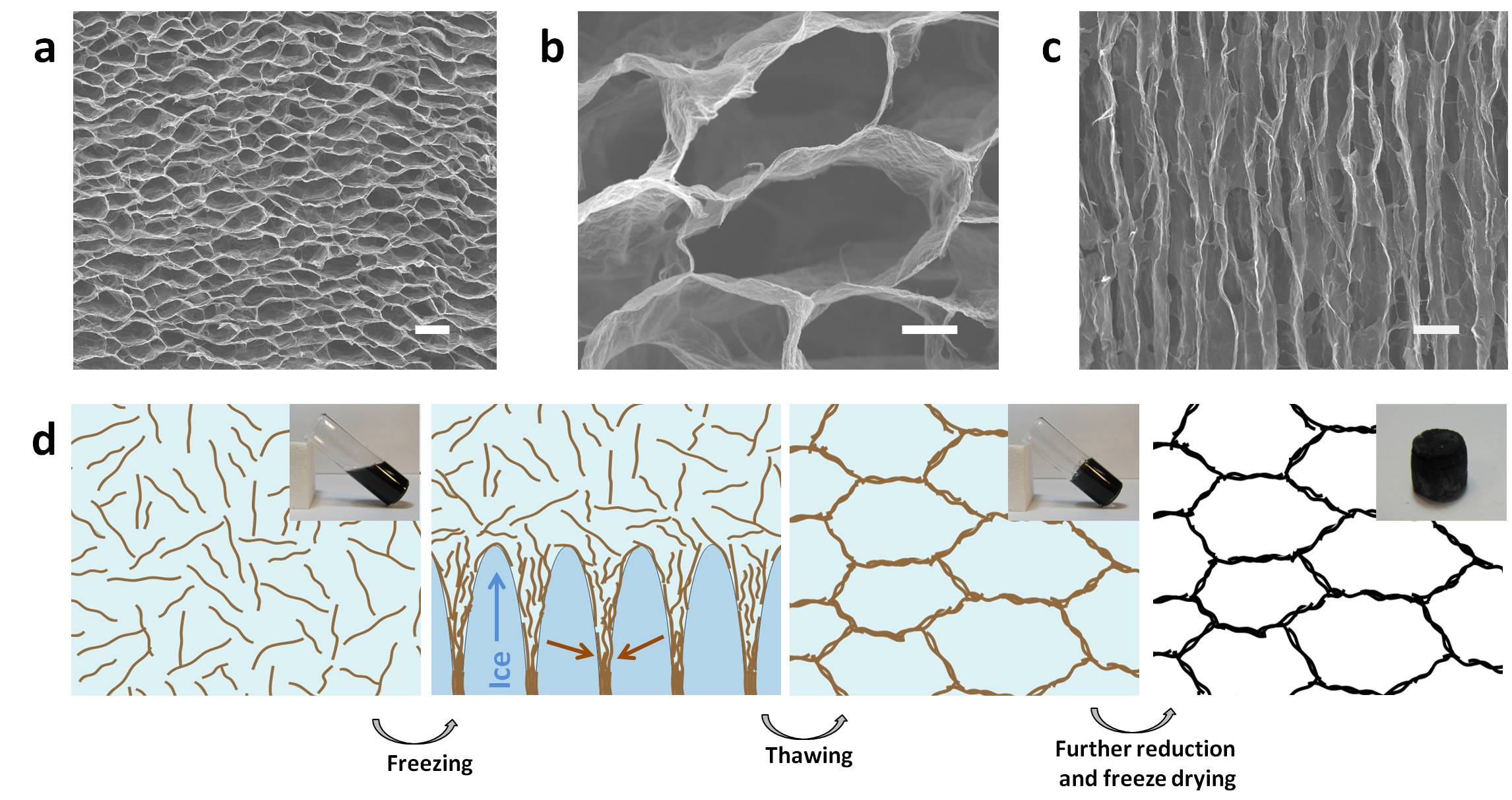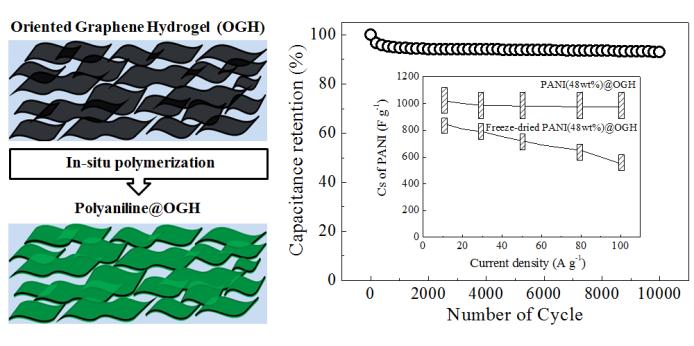

Home Highlights Research People Publications Patents Contact Openings Links
Our research involves a crossing area of soft matter,biomimetics and graphene.

Since 2006, we have been developing new "soft" concepts to address the key scientific and technical challenges relating to scalable synthesis, processing and assembly of graphene-related materials. We are particularly passionate to develop graphene-based soft materials for a broad range of technological applications (see our recent review in Advanced Materials for an overview of this exciting multidisciplinary area and two recent examples of graphene-enabled new materials published in Nature Communications and Science).
Solution-phase graphene synthesis and processing
Colloidal and interfacial properties of graphene-derived molecules
Biomimetic, graphene-based soft materials
Nanofluidics based on multilayered graphene membranes
Graphene-enabled new multifunctional materials
Novel applications of graphene-derived soft materials
Please see below for some snapshots of our research:
Solution-Phase Graphene Synthesis and Processing
Our group has demonstrated that stable aqueous graphene dispersions can be readily prepared by chemical conversion of inexpensive, natural graphite flakes, without the need for any foreign dispersants (Nature Nanotechnology 3, 101-105, 2008). This success enables the use of low-cost, solution processing techniques to combine individual graphene sheets into a range of macroscopic, practical and useable forms, bringing graphene a significant step closer for bulk applications (Science 320, 1170-1171, 2008).
Colloidal and Interfacial Properties of Graphene-Derived Molecules
We have been looking at the unique physical and chemical properties of solvated, particularly hydrated graphene sheets. Solvation can activate various colloidal forces, allowing graphene sheets to interface with each other and other functional nanomaterials in ways that are impossible for dried counterparts. Solvation not only enables the solution processability of graphene, but more importantly, offers new unique avenues to tailor its functionalities and enables novel applications that are unattainable with dried graphene.
For example, we have found that the molecular configuration of chemically converted graphene can be readily manipulated in solution (Chemical Communications, 47, 5810-5812, 2011); The assembly behavior of hydrated graphene was found to be significantly different from that of dried counterparts (Advanced Materials, 23, 2833-2838, 2011); Interaction between colloidal graphene oxide and gold nanoparticles can be well controlled by adjusting the solution chemistry (Chemistry: a European Journal, 17, 5958-5964, 2011).
Biomimetic, Graphene-Based Soft Materials
All biological tissues are more or less hydrated and most are ''soft''. By contrast, most of man-made functional materials and devices including graphene are routinely used or supplied in a dried, ''hard'' form, even iftheir ultimate uses involve the contact with a liquid. We have been particularly interested in the unique roles of water or solvents in graphene-based bulk materials.
We
have discovered that chemically converted graphene can self-gel at the
liquid-solid interface in a face-to-face manner to form an oriented
conductive hydrogel film during filtration. This unusual gelation
behavior enables a new generation of electroconductive hydrogels
combining exceptional mechanical strength, high electrical
conductivity, mechanical flexibility, and anisotropic responsive
properties (Angewandte Chemie International Edition, DOI: 10.1002/anie.201100723).
In contrast to the common expectation, hydrated graphene sheets can
remain largely separated by hydration forces when face-to-face stacked
together, allowing the extraordinary properties of individual sheets to
be effectively harnessed in a readily-available, macroscopically-usable
film form. This provides an extremely simple solution to address a
long-standing challenge related to the large-scale utilization of
graphene in a bulk form. We have found that solvated graphene sheets
can remain largely separated in multilayered films, enabling the
creation of a new generation of energy storage devices that can combine
ultrahigh energy/power density and ultrafast charge/discharge rates (Advanced Materials, 23, 2833-2838, 2011).

Many applications proposed for graphene require multiple sheets be assembled into a monolithic structure. The ability to maintain structural integrity upon large deformation is essential to ensure a macroscopic material functioning reliably. However, it has remained a great challenge to achieve high elasticity in three-dimensional (3D) graphene networks. We have demonstrated that the marriage of graphene chemistry with ice physics can lead to formation of ultralight and superelastic graphene-based cellular monoliths. Mimicking the hierarchical structure of natural cork, the resulting materials can sustain their structural integrity under a load of 50,000 times their own weight and can rapidly recover from 80% compression. The unique biomimetic hierarchical structure also provides this new class of elastomers with exceptionally high-energy absorption capability and good electrical conductivity. The successful synthesis of such fascinating materials paves the way to explore the applications of graphene in a self-supporting, structurally adaptive and 3D macroscopic form (Nature Communications, DOI: 10.1038/ncomms2251)
Nanofluidics Based on Multilayered Graphene Membranes
The analysis and control of ionic flow confined in nanospace is widely involved in myriads of scientifically and technologically important areas ranging from biochemical analysis, power generation, environmental protection and signaling. Previous research on nanofluidics centers on fundamental understanding of the mass transport phenomena in single-channel device. Having become a rapid progressing research field yet many challenges remain particular in device fabrication, modification and characterization. We have successfully demonstrated that a multilayered graphene membrane can be readily fabricated via easily accessible filtration technique; (Angewandte Chemie International Edition, 32, 7325-7328) With corrugated graphene sheets stacking face-to-face, the membrane is thus endued with an interconnected nanochannel network with a slit-shape channel dimension which is different from carbon-nanotube-based membranes. This macroscopic membrane has excellent mechanical strength and structural integrity and is essentially a multi-channel fluidic device. (Chemical Communications, 47, 5810-5812, 2011)
Taking advantage of the versatile non-covalent interactions and the unique two-dimensional configuration among graphene sheets, we have achieved structural tuning of the multilayered graphene membrane with the nanochannel dimension inside scaling from 0.5 to 10 nm. We have also developed a dynamic electrosorption analysis technique to characterize the structure of this series of multilayered graphene membranes. This technique is of great value in complimentary conventional gas-adsorption technique to reveal the microstructure of a bulk electroconductive porous materials. (Chemistry - A European Journal, DOI: 10.1002/chem.201203219)
The multilayered graphene membranes with chosen range of nanochannel dimension can show selective permeation to both nanoparticles and ionic species. Specifically, the selective effect of multilayered graphene membranes is prominent when the nanofluidic structure of the membranes is controlled to be comparable to the size of ions being tested. (Progress in Natural Science: Materials International, DOI: 10.1016/j.pnsc.2012.11.002) With all the properties combined, namely the ease of fabrication, handling, structure/chemistry tuning and the selective permeation to a wide range of species, the multilayered graphene membranes can serve as an unconventional nanofluidic experimental platform to understand and demonstrate fundamental phenomena as well as applications that cannot with traditional nanofluidic devices (Advanced Materials DOI:10.1002/adma.201203567).
Graphene-Enabled New Multifunctional Materials
Graphene and its derived molecules are not only useful on their own, but can also serve as a unique molecular platform to enable the synthesis of other novel functional nanomaterials that are difficult to prepare using conventional techniques. Graphene derived molecules can play an extraordinary enabling and assisting role in the synthesis of other new unique materials.
We have demonstrated that graphene oxide (GO) can serve as a superior dispersant to disperse pristine carbon nanotubes into water to form stable suspensions. These discoveries offer an amazingly simple, cost effective and environmentally friendly strategy to address the long-standing processablity issue of carbon nanotubes. It also allows convenient integration of the one dimensional (1D) carbon nanotubes with the 2D graphene to form hierarchically structured carbon nanohybrids with enhanced performances (Chemistry-a European Journal, 16, 10653-10658, 2010).

We have discovered that a combination of a planar configuration, self-contained functional groups and large molecular size can make GO act as both a rigid flat substrate and a powerful dispersant. GO sheets can serve as the world's thinnest, functionalized flat substrate to enable the synthesis of a new class of uncapped, yet solution-dispersible nanoparticle assemblies. (Chemistry: a European Journal, 17, 5958-5964, 2011). Polyaniline has long been explored as a potential candidate for supercapacitors. However, its limited rate capability and cyclability, along with large variation of reported capacitance, cast doubt on its potential for real-world applications. We use the graphene hydrogel film as a nano-scaffold to revisit the capacitance of polyaniline, and reveal that if its nanostructure is properly engineered, polyaniline can provide a combination of high capacitance, excellent rate performance and long cycling life and is promising for real applications (Energy & Environmental Science, DOI: 10.1039/c2ee24018a)
Novel Applications of Graphene-Derived Soft Materials
Energy harvesting and storage
Nanofluidics and separation membranes for water purification/desalination
Chemical and biological sensors
Drug control release and electroconductive tissue scaffolds
High performance nanocomposites
|
|
Last Upadated Dec 2012 |